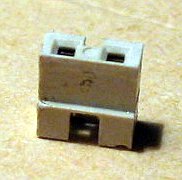Jumper (electrical engineering)
Jumpers (German also short-circuit bridges ) are small jumpers that are plugged into the contacts of pin headers as a form of short-circuit plug. This electrically connects the pins to which these jumpers are plugged ("bridged"). Applications are primarily in the field of electronics and, above all, in computer technology and digital technology , in order to define certain default settings or functions of components, such as the SCSI ID of a hard disk or an on / off status. Configuring with jumpers is called jumpers in technical jargon . The size of a jumper is a few millimeters, the usual pitch is 2.54 mm.
shape
Jumpers are a special form of short-circuit plug that differ in terms of their design, size and application. While jumpers are designed like a socket, short-circuit plugs are equipped with pins. Larger designs of short-circuit plugs are also used in electrical installations or in the field of electrical prototype construction on breadboards .
construction
A jumper usually consists of a small, slightly curved leaf made of spring steel that directly connects the contacts (pins) to be bridged. To build up the necessary spring pressure, to protect against short circuits with neighboring contacts and to make them easier to handle, the metal bridges are provided with a plastic housing . The jumper is placed on two adjacent pins, which creates an electrical contact via the spring . The pins and springs are to minimize contact resistance and avoid corrosion usually gilded .
DIP switches can also perform the same function as jumpers . Jumpers, however, are much cheaper, more reliable, and take up less space. However, these advantages are offset by a more cumbersome handling due to the small size of the jumpers.
Jumpers are manufactured in different sizes to match the pitch and the pin thickness of the pin headers used. Common grid dimensions are 2.54 mm, 2 mm and 1.27 mm.
function
Jumpers are used to configure an electronic assembly or to set operating parameters, provided that these settings are made rarely or even only once during commissioning. As a rule, ground connections are made using the jumper . Together with a pull-up resistor , information corresponding to one bit is made available in this way .
In the case of SCSI drives, for example, the ID numbers are determined using a combination of three or four jumpers, which together form the three or four bits of the ID number . In parallel ATA - Disk the jumpering for determining the ATA Device number (0 or 1 for master to slave) that determines whether it is ATAPI bus is the first or second drive on the corresponding ATA / serving.
Mechanically, jumpers often have a grip edge to make pulling easier. In the middle there is a recess so that the jumper can be pulled out with a small hook in tight spaces. Both features can be seen in the photo on the right.
variants
Solder jumper
Solder jumpers are closely spaced areas of tin on a circuit board. They are not connected with a jumper, but with a sufficient amount of solder . This connection can just as easily be separated using a soldering iron and desoldering pump . Solder jumpers are less flexible means of configuration and are typically changed less often than plug-in jumpers. If short soldered pieces of wire or wire bridges are used instead of a pure solder bridge, this is also referred to as strapping.
Depending on the basic setting, there is already a conductor path between the soldering pads for the initial connection. This has to be done with a sharp object for a desired break. B. a cutter - be separated; hence the term “ Schnitzbrücke ” in the jargon .
The typical application of solder jumpers are assembly variants . This means that if you want to change a soldering bridge meaningfully, you have to re-solder another component anyway. In the case of automatically assembled printed circuit boards, soldered and carved bridges are replaced in favor of zero ohm resistors .
Toggle switch
A changeover switch can also be implemented with a jumper. To do this, the pin headers must have three contact pins. The changeover contact is the middle contact pin. The jumper is used to connect it to either the right or the left.
Undocumented jumper settings
Hardware manufacturers generally document all possible or useful combinations of set and unset jumpers. However, there are a number of cases where certain functions were implemented in the hardware at the time of production, but these were deactivated by jumpers (not set) and were not included in the documentation. Possible reasons can be:
- Imperfections in additional features;
- Marketing aspects : The same product can be sold in two versions at different prices, but due to the higher production figures it is still cheaper overall than two actually different product versions;
- Extended functions cannot be used by the other components at the time of delivery;
- Functions are only required for service purposes or in-house for production and are of no importance to the owner of the product or are not intended for use.
Resourceful and adventurous users will always find undocumented jumper settings and publish them on the Internet. This is most common with computer mainboards , but there are also examples of this in the case of CD-ROM drives or host bus adapters . Mainboards are mostly voltage values for the CPU or settings that affect the clock frequency .
Web links
Individual evidence
- ↑ Younger (2012) Jumper patent on a special design that should not be lost by not removing it to switch it off, but simply turning it upside down, PDF file
- ↑ PC workshop, p. 262 Online
- ↑ Solder jumper in the Commodore floppy VC 1541



